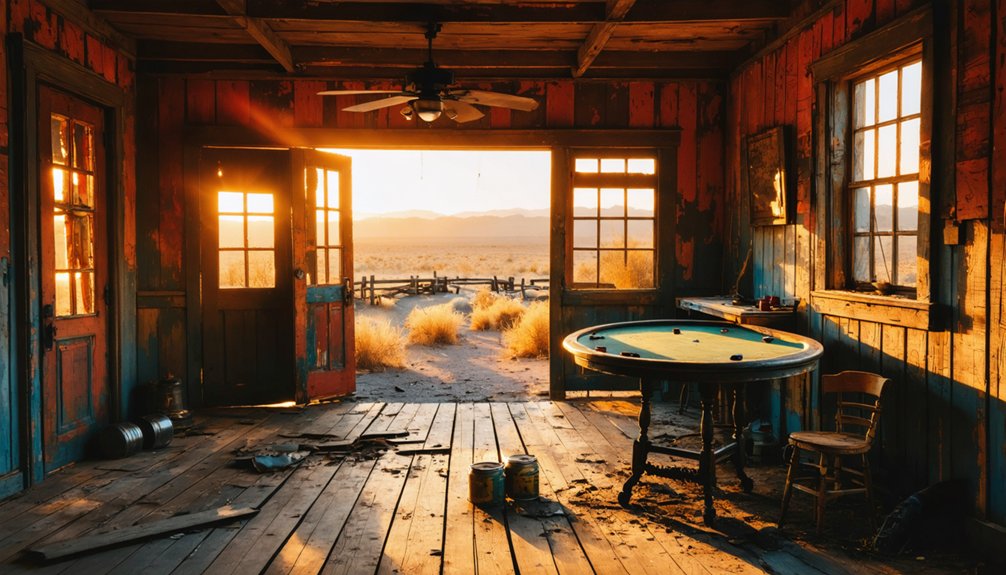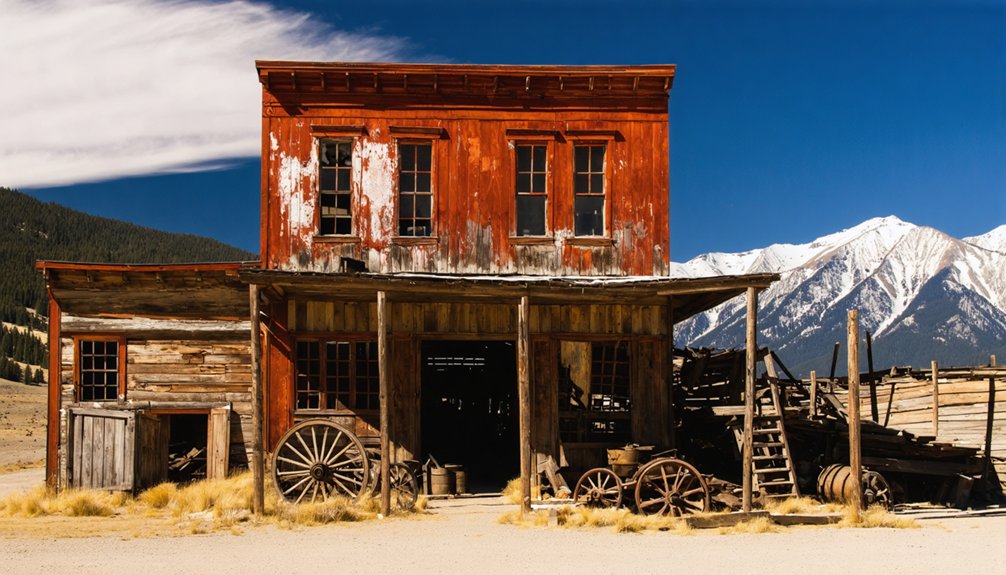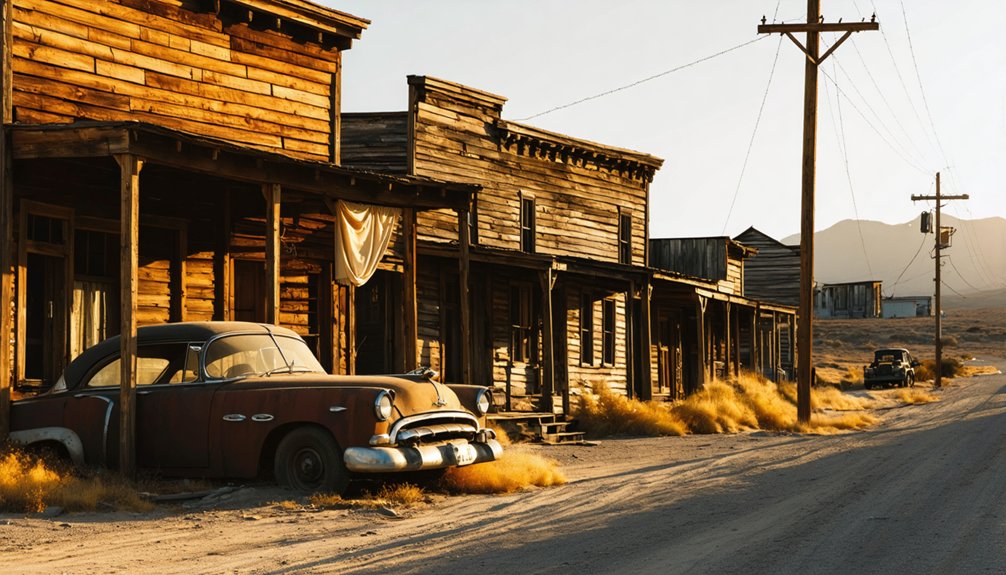Capturing the haunting beauty of Old West ghost towns requires timing your visit during golden hours when warm light accentuates weathered textures. You’ll need a sturdy tripod, wide-angle lenses, and patience to document architectural decay that tells stories of boom-and-bust cycles. Spring and fall offer ideal weather conditions without extreme temperatures or crowds. Respect these sites by obtaining permissions and never disturbing artifacts. The silent wooden structures await your camera to preserve their fading history.
Key Takeaways
- Shoot during golden hour when warm light accentuates weathered textures, rust, and peeling paint in abandoned structures.
- Frame compositions through doorways or windows to create depth and portray the nostalgic emptiness of ghost towns.
- Use tripods and wide-angle lenses to capture both sweeping views and architectural details in diminishing light conditions.
- Document decay patterns in wooden structures which tell stories of boom-and-bust cycles in frontier economies.
- Visit during spring or fall for optimal weather conditions and fewer crowds when photographing preserved Old West settlements.
The Rise and Fall of Frontier Boomtowns
While numerous factors contributed to their swift emergence, frontier boomtowns of the American West materialized almost overnight during the mid-to-late 19th century, transforming barren landscapes into bustling centers of commerce and opportunity.
You’d witness remarkable boomtown evolution following discoveries like the Comstock Lode in 1859, which created Virginia City virtually overnight. Towns frequently changed names multiple times, reflecting their chaotic growth patterns.
These settlements thrived on mining, cattle drives, and commerce until inevitable decline set in. The social upheaval was profound—cowboys, miners, gamblers, and outlaws created volatile communities that eventually gave way to more structured societies. Notable lawmen like Wyatt Earp attempted to maintain order amid the chaos of these rapidly growing towns.
Lawless frontier economies burned bright but brief, yielding to civilization’s ordered advance when their wild energy faded.
When resources diminished or railroads bypassed them, these single-industry economies collapsed. The harsh conditions of these environments often led to the development of dry farming techniques as settlers attempted to sustain themselves in arid regions. Towns that once bustled with thousands suddenly emptied, leaving behind the silent structures we now call ghost towns.
Golden Hour Photography in Abandoned Settlements
When photographers speak of “the golden hour,” they’re referring to those magical moments after dawn and before dusk when sunlight transforms abandoned settlements into haunting works of art.
During this time, warm light filters through broken windows, illuminating dust particles and casting long shadows that accentuate architectural decay. Ghost towns like Bodie, California offer perfect opportunities to capture this interplay of light and shadow against historic structures.
You’ll find the soft, directional light perfect for highlighting textures—rust, peeling paint, and weathered wood come alive with dimension.
Bring a tripod for stability as light diminishes, and consider using wide-angle lenses for expansive interiors or primes for intimate details.
Frame your shots through doorways or windows to create natural depth. Manual exposure settings give you control over the high contrast scenes typical of golden hour light quality.
Don’t just shoot buildings—focus on details that tell stories of sudden abandonment and nature’s reclamation.
Proper research before visiting is crucial as many locations have specific regulations regarding photography equipment and access times.
Telling Stories Through Architectural Decay
When you frame a shot through a broken window in a ghost town, you’re capturing a literal portal between past and present where light filters through exactly as it did a century ago.
The distinct grain patterns and weathering of old-growth timber tell specific stories about the harsh environmental conditions these structures endured, from scorching summers to bitter winters.
These architectural remains aren’t just photographic subjects but historical documents that reveal the economic rise and fall of Western frontier communities through their physical deterioration. In places like Bodie, visitors can explore over 170 structures that have been preserved in a state of “arrested decay” since its gold mining heyday. The arid landscape of the American West has allowed for exceptional preservation without overgrowth, creating photographic opportunities impossible to find in more humid regions.
Windows as Time Portals
Standing before a ghost town’s weathered facade, you’ll notice how windows serve as the most revealing time portals into the abandoned West. Each broken pane and empty frame tells a chronological story of desertion—buildings with intact glass standing in stark contrast to those where nature has completely reclaimed the space.
Through these architectural openings, you’ll glimpse frozen domestic scenes—abandoned rocking chairs, cooking equipment, and personal items left exactly as they were decades ago. Many visitors are particularly moved by finding remnants of daily frontier life, creating a profound emotional connection to the past. The window symbolism extends beyond mere openings; they’re visual markers documenting environmental exposure and structural decline. Much like in Pripyat, these sites resemble outdoor museums with history frozen in time, preserving the narrative of human endeavor and economic changes.
When composing photographs, use these frames within frames to create dramatic depth. The architectural nostalgia becomes most powerful where light and shadow play across interior spaces, casting geometric patterns that emphasize the haunting beauty of these forgotten places.
Weathered Wood’s Silent History
As you explore the skeletal remains of ghost towns across the American West, weathered wooden structures become textural history books waiting to be read.
You’ll notice how UV radiation has bleached facades silver-gray, while temperature fluctuations have created dramatic cracks and splits that map decades of neglect.
These weathered textures reveal construction secrets—hand-hewn beams and mortise-and-tenon joints emerge as paint surrenders to the elements.
Decay patterns in sagging rooflines and warped porches tell stories of sudden abandonment and economic collapse.
Each termite tunnel and water stain chronicles the forces of nature reclaiming human ambition.
The silent testimony of peeling paint and rusted nails frozen in weathered planks symbolizes more than deterioration—it captures the boom-and-bust cycle that defined frontier dreams.
Places like Silver City Ghost Town stand as perfect examples of this architectural storytelling within California’s historic gold rush landscape.
When photographing these structures, consider using wide-angle lenses to capture the full scope of architectural deterioration in a single compelling composition.
Preserving History One Frame at a Time
When you document ghost towns, you’re creating visual time capsules that future generations will rely on for historical context and preservation efforts.
Your photography requires both technical skill—using natural light and appropriate equipment—and ethical awareness to avoid disturbing artifacts or trespassing on protected sites.
You’ll contribute most meaningfully to historical archives by cataloging your images with precise location data, contextual information, and by making them accessible through digital preservation platforms.
Photographic Documentation Techniques
Photographic documentation serves as the most powerful tool in preserving ghost towns before time and elements erase these historical treasures completely.
You’ll need robust equipment including tripods for stability in low light and durable gear that withstands harsh outdoor conditions. Wide-angle lenses capture main streets while detailed shots of forgotten artifacts tell intimate stories.
Master composition techniques that emphasize ghostly silhouettes and architectural textures. Shoot during golden hours when directional light accentuates weathered surfaces, or try long exposures to create ethereal atmospheres.
Light painting selectively illuminates dark interiors without overwhelming the scene.
In post-processing, resist heavy manipulation. Subtle contrast adjustments or thoughtful black-and-white conversion can enhance mood while maintaining historical integrity.
Your goal is authentic preservation, not artificial enhancement.
Ethical Capture Considerations
Ethical capture of ghost towns extends far beyond technical skill, demanding a conscientious approach to these fragile historical sites.
Always secure proper permissions before entering private property—even abandoned structures have owners. Your freedom to explore doesn’t override others’ rights.
Show cultural respect by researching a town’s significance beforehand. Many sites hold spiritual importance to Indigenous peoples or descendants of original inhabitants.
Photograph with integrity: never move artifacts, climb on structures, or leave your mark.
In post-production, resist the urge to manipulate images beyond natural enhancement. Dramatic edits might generate likes but distort historical truth.
Instead, pair your photographs with accurate context that educates viewers about these vanishing treasures.
Your responsible documentation helps preserve these irreplaceable windows into America’s frontier past.
Digital Archive Development
Beyond capturing striking images, today’s photographers are becoming digital archivists, preserving ghost towns through sophisticated technological means.
You’ll find them deploying 3D scanning, photogrammetry, and drone technology to create thorough digital preservation records of these fading remnants.
When you explore these digital archives, you’re accessing more than photos—you’re entering georeferenced 3D models integrated with historical documents and maps.
Modern archival technology follows strict standards: metadata tagging for searchability, multiple backup systems, and cloud-based platforms for collaborative research.
These open-access repositories serve freedom-seeking researchers while protecting history from physical deterioration.
When exploring abandoned settlements frozen in time, photographers face a complex web of ethical considerations that extend far beyond simply capturing compelling images.
You’re obligated to research property status beforehand—many ghost towns remain privately owned despite appearances. Always secure permission to avoid trespassing.
Ethical storytelling demands you leave everything as you found it. Don’t disturb artifacts, create hazards, or alter scenes for better compositions.
Cultural preservation requires staying on established paths and avoiding damage to fragile structures.
Your safety depends on planning for hazards—unstable buildings, wildlife, and weather conditions. Travel with companions when possible.
Share your images with transparency about editing, and distribute location information responsibly to prevent vandalism and overexposure of these irreplaceable historical treasures.
Weather Elements That Enhance Atmospheric Shots
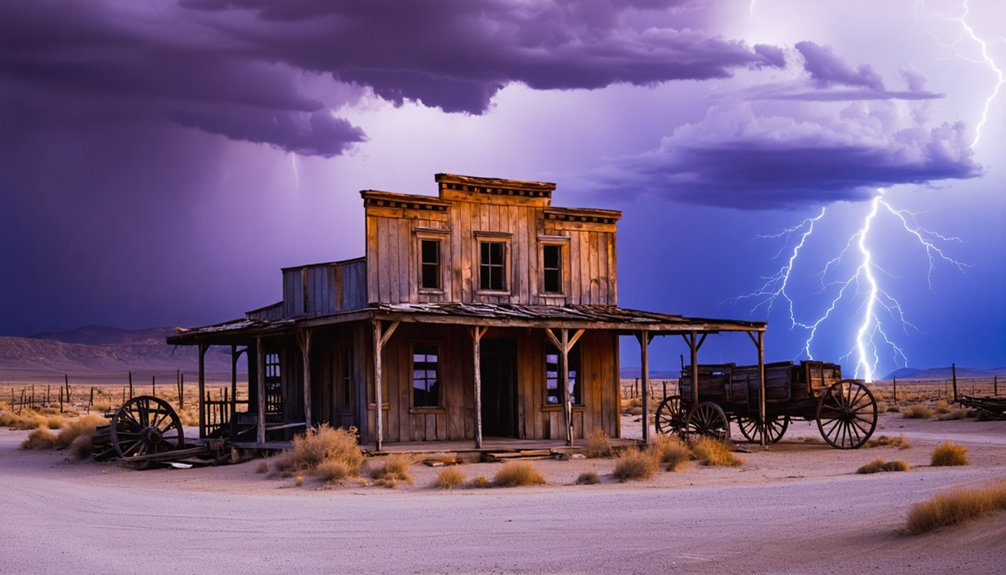
Weather transforms ghost town photography from simple documentation into evocative visual storytelling.
Cloudy atmospheres diffuse light, eliminating harsh shadows while revealing subtle textures in weathered buildings. When rain creates reflective surfaces, your compositions gain mirror-like qualities that double visual elements and enhance the abandoned atmosphere.
The soft embrace of overcast skies unveils forgotten textures, while rain transforms desolation into reflective poetry.
Embrace twilight tones during blue hour for cool, muted colors that amplify the haunting essence of these forgotten places.
Atmospheric movement from wind adds cinematic layers—stirring vegetation against static structures creates compelling visual tension.
Don’t overlook seasonal moods; winter frost and summer overgrowth each tell different stories of abandonment.
For truly eerie lighting, try shooting during storm approaches or capture the “spotlight effect” when cloud breaks selectively illuminate features.
Moonlight’s natural 4000K color temperature maintains night’s mystery while revealing details otherwise lost in darkness.
Essential Gear for Remote Location Shooting
Successful ghost town photography depends on three essential gear categories when shooting in remote locations.
Your remote shooting toolkit should prioritize a capable camera system—either mirrorless (Sony alpha or Canon EOS R) or DSLR with full-frame sensor for superior low-light performance. Pack multiple lens options: wide-angles for town layouts, 50mm primes for versatility, and 85mm for detail isolation.
Don’t underestimate stabilization equipment in your gear checklist. Tripods enable steady long exposures in dim interiors, while gimbals compensate for uneven terrain.
Consider portable lighting solutions like battery-operated strobes for illuminating shadowed areas. Drones like the DJI Mavic 2 Pro capture dramatic aerial perspectives impossible from ground level, revealing the complete layout of these forgotten settlements.
Mining Camp Aesthetics: From Saloons to Stamp Mills
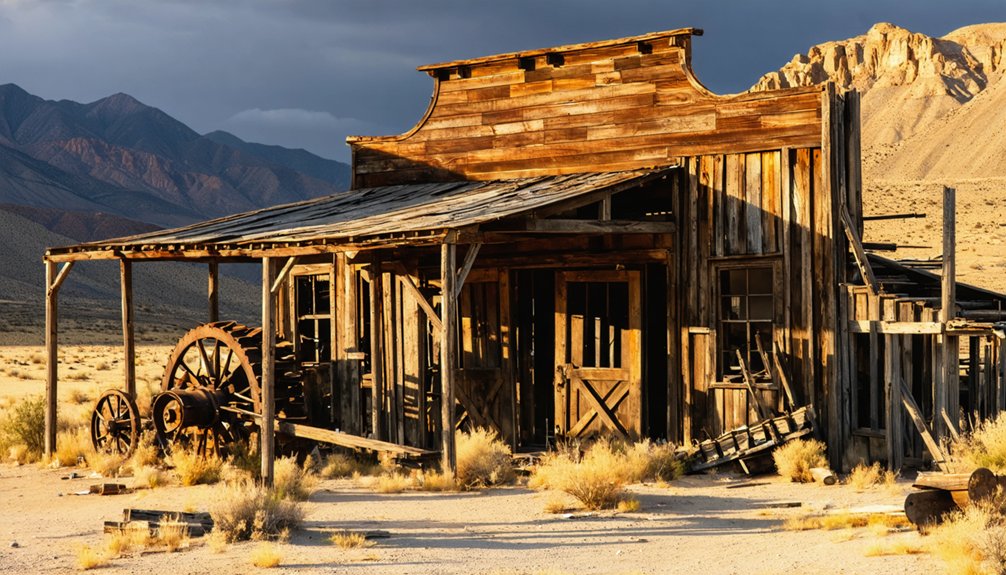
With your gear packed for remote shooting, you’ll now face the heart of ghost town photography: the distinctive structures that defined Western mining communities.
From weathered saloon fronts to industrial stamp mills, these architectural elements tell the story of frontier ambition and saloon culture.
When capturing mining aesthetics, focus on:
- False fronts that gave humble buildings an illusion of grandeur
- Contrast between social structures (saloons, general stores) and industrial elements
- The weathered textures of original materials—wood warped by decades of sun and snow
As you frame these structures, you’re documenting more than buildings; you’re preserving the visual language of boom-and-bust economies where miners sought fortune and found community in harsh landscapes.
Finding Hidden Gems Off the Tourist Trail
Beyond the refurbished facades of popular tourist destinations like Bodie and Calico lie the true treasures of Western ghost town photography.
You’ll find these hidden treasures scattered across isolated regions of Nevada’s deserts, Montana’s mountains, and Wyoming’s plains—often accessible only via rough roads requiring high-clearance vehicles.
Before setting out, research land ownership and regulations through BLM or USFS databases. Many authentic sites sit on public lands, though some require permission to access.
Look for structures showing genuine abandonment—collapsed buildings, exposed interiors, and minimal signage—where forgotten histories reveal themselves through rusted machinery and overgrown foundations.
Pack emergency supplies, protective clothing, and navigation tools, as cell service rarely reaches these remote locations.
Document what you find through photography and notes, but always leave artifacts undisturbed.
Seasonal Considerations for Ghost Town Expeditions

The timing of your ghost town expedition can make the difference between a rewarding photographic adventure and a potentially dangerous ordeal.
Spring and fall offer ideal weather preparedness conditions with temperatures between 50-80°F, perfect for exploring and seasonal photography without extreme heat or winter hazards.
- Summer brings crowds and temperatures exceeding 100°F in desert locations, requiring extra water and sun protection.
- Winter access often becomes impossible without four-wheel drive as snow covers remote mountain roads.
- Monsoon season (July-September) creates flash flood risks and muddy conditions that can strand vehicles.
Your off-season visits will provide more authentic experiences with fewer tourists, but require additional planning.
Always check local forecasts and road conditions before heading to these remote historical treasures.
Frequently Asked Questions
Are Permits Required to Photograph Specific Ghost Towns?
Yes, you’ll need photography permits for commercial shoots in most ghost towns. Regulations vary by location’s ownership, with private sites and popular attractions enforcing stricter ghost town regulations.
How Can I Capture Paranormal Elements Some Visitors Report Experiencing?
62% of paranormal investigators capture EVPs in ghost towns. You’ll need night vision equipment for spiritual photography, while documenting temperature drops and recording ambient sounds can help preserve evidence of ghostly encounters during your visit.
What Drone Regulations Apply When Filming Ghost Towns?
You’ll need FAA registration for drones over 250g, Part 107 certification for commercial filming, and permission from property owners. Always maintain line-of-sight, stay below 400ft, and respect drone safety and filming guidelines.
Do Indigenous Histories Intersect With Ghost Town Narratives?
Yes, they’re inseparable. You’ll discover indigenous perspectives beneath every ghost town, as these settlements often displaced native communities, erasing their cultural significance while simultaneously preserving fragments of their original presence in the landscape.
How Do I Respectfully Photograph Sites With Remaining Human Artifacts?
While you might be tempted to move artifacts for better shots, ethical photography demands you leave everything untouched. Photograph human artifacts as found, use non-intrusive lighting, and maintain a respectful distance from all historical items.
References
- https://www.blackhillsbadlands.com/blog/post/old-west-legends-mines-ghost-towns-route-reimagined/
- https://m.dresshead.com/files/scholarship/Documents/Ghost_Towns_Lost_Cities_Of_The_Old_West_Shire_Usa.pdf
- https://www.geotab.com/ghost-towns/
- https://truewestmagazine.com/article/old-west-ghost-towns/
- https://www.losethemap.com/scariest-ghost-towns-in-the-world/
- https://www.youtube.com/watch?v=2sIM72082jc
- https://www.britannica.com/topic/ghost-town
- https://en.wikipedia.org/wiki/Ghost_town
- https://www.youtube.com/watch?v=V1YyyBL7cgc
- https://wildwestcity.com/old-west-ghost-towns/
